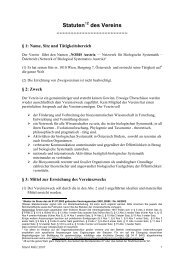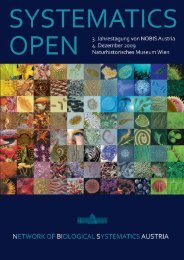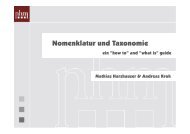4. Jahrestagung von NOBIS Austria 2. - 3. Dezember 2010
4. Jahrestagung von NOBIS Austria 2. - 3. Dezember 2010
4. Jahrestagung von NOBIS Austria 2. - 3. Dezember 2010
You also want an ePaper? Increase the reach of your titles
YUMPU automatically turns print PDFs into web optimized ePapers that Google loves.
What are conodonts?<br />
Suttner, T.J. 1<br />
1 <strong>Austria</strong>n Academy of Sciences (CPSA) c/o University of Graz - Institute for Earth Sciences (Geology<br />
& Paleontology), Heinrichstrasse 26, A-8010 Graz, e-mail: thomas.suttner@uni-graz.at<br />
Conodonts are a group of extinct marine organisms that are divided into Proto-, Para- and<br />
Euconodonta. Commonly fossil remains are represented by 0.5-4-mm sized discrete elements<br />
consisting of apatite. These elements were in use as biostratigraphic tool for Palaeozoic to low<br />
Mesozoic strata long before the first “conodont-animal” was discovered (Briggs et al., 1983). As soon<br />
as fused conodont clusters, bedding plane or natural assemblages were known, it became obvious<br />
that several element types (S, M and P elements) belong to distinctive apparatuses. Since its<br />
discovery by Pander in 1856 about 284 genera are described, which result in more than 3000 species.<br />
Until now the phylogeny of conodonts is still controversial.<br />
Szaniawski (2002) discussed the chemical composition and anatomical similarity of simple cone<br />
elements of protoconodonts in comparison with spines of the grasping apparatus of chaetognaths. On<br />
the basis of molecular investigations he concluded that chaetognaths should have originated at about<br />
the same time as protoconodonts, and that protoconodonts of the lineage of Phakelodus probably<br />
formed a stem group of chaetognaths. In contrast, Euconodonta are considered as early vertebrates<br />
probably being more derived than hagfish or lamprey (Donoghue and Purnell, 2005). This is based on<br />
about 13 natural assemblages of Euconodonta from Scotland, South Africa and Canada. Specimens<br />
are about 4-10-cm large, elongate, possessing a head with eyes, extrinsic eye muscles, a notochord,<br />
chevron-shaped muscle blocks, a caudal fin, features that they share with jawless vertebrates. But<br />
they also possess a mineralized dermal skeleton, which is considered as gnathostome apomorphy.<br />
That shows that within the Conodonta fossil groups of different origin might be lumped and that<br />
Euconodonta may be more closely related to living jawed vertebrates rather than to lampreys. The<br />
only way to learn more about the true nature of conodonts is the discovery of additional natural<br />
assemblages and the examination of diagenetic processes affecting hard and soft tissue during<br />
fossilization (e.g. solution of calcium carbonate, emplacement of phosphate).<br />
Briggs, D.E.G., Clarkson, E.N.K., Aldridge, R.J. 198<strong>3.</strong> The conodont animal, Lethaia, 16, 1-1<strong>4.</strong><br />
Donoghue, P.C.J., Purnell, M.A. 2005. Genome duplication, extinction and vertebrate evolution. TRENDS in<br />
Ecology and Evolution, 20, 312-319.<br />
Szaniawski, H. 200<strong>2.</strong> New evidence for the protoconodont origin of chaetognaths, Acta Palaeontologica Polonica,<br />
47, 405-419.<br />
_____________________________________________________________________________<br />
Ber. Inst. Erdwiss. K.-F.-Univ. Graz, Band 15, <strong>2010</strong>; ISSN 1608-8166 45






